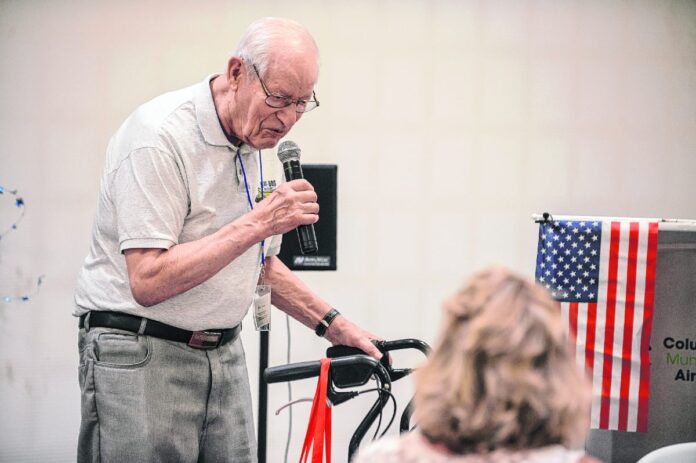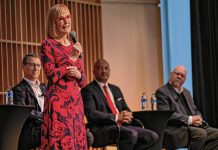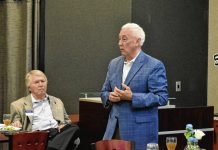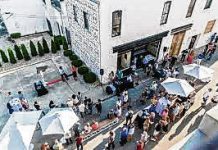
A half-century after they returned from Vietnam, a group of nearly 50 former military reservists renewed their ties at a reunion at what was once their home base.
The reunion for the 71st Special Operations Squadron at Columbus Municipal Airport occurred on the 75th anniversary of D-Day, at the same location where Bakalar Air Force Base was located from 1942 to 1970.
In all, about 110 people attended the reunion, including spouses and family members.
Looking around at a number of veterans he served with in Vietnam, former squadron member Terry Bickers of Columbus said he saw some lifelong friends that he has remained close to over the decades.
[sc:text-divider text-divider-title=”Story continues below gallery” ]
“Having the common experience of serving together in Vietnam is very important,” Bickers said. “But today, I have to look at name tags to see who the other guys really are. I was 23 when we were in Vietnam, and now I’m 73. We have all changed.”
Another former member of the 71st, Don Miller of North Vernon, expressed similar thoughts.
“It seems like another life because it was so long ago,” Miller said.
Activated on April 11, 1968, the reservists with the 71st Special Operations Squadron reported for active duty in Columbus a month later on May 13, 1968.
They arrived at Nha Trang Air Force Base in Vietnam on March 2, 1969, and spent their time at Phan Rang Air base, a forward operating location in the southeastern part of the country.
Their mission was to protect U.S. ground troops with AC-119 gunships and eliminate the enemy. One of their responsibilities was to “take gray and white cargo birds (the gunships), and turn them into black and camouflaged fighting machines,” according to Mike Drzyzga, president of the AC-119 Gunship Association.
You did it,” Drzyzga wrote in a letter to the veterans at the reunion. “You forged the way to southeast Asia with ‘Shadows’ — a reference to aircraft modified for close-support and airbase defense roles.
A gunner on a Shadow during the Vietnam War, Drzyzga also credited the reservists from Bakalar with providing exemplary training for their replacements before returning stateside.
“We did something very adventuresome and much appreciated while we were in Vietnam,” said former squadron member Al Heuss, a former colonel and pilot in the 71st Special Operation Squadron who now resides north of Indianapolis.
Fifty years later, only a maintenance hangar, chapel and control tower remain as recognizable items from the Bakalar days, according to event co-organizer and former squadron member Jim Alvis of Carmel.
The 71st was inactivated in 1973 and its AC-119s were retired. However, the unit’s current version was reactivated in 2005 as a helicopter squadron attached to Kirtland Air Force Base in New Mexico.
Lt. Col. Matthew Shrull, current commander of the 71st, flew in from Albuquerque to attend Thursday’s event and address the veterans.
“Thank you for your legacy of courage and honor that you started 50 years ago,” Shrull told the former reservists. “We are doing our best to make sure we are holding the high standards that all of you have set.”
Shrull presented frame artwork of a CV-22 Osprey, the type of helicopter now flown by the squadron, as well as a history of the 71st Special Operations Squadron that goes back to World War II.
The artwork is expected to be displayed in the air museum, Alvis said.
Missions carried out by the 71st were almost always at night, according to reunion co-organizer and former squadron member Jim Alvis of Carmel.
Although there were some unpleasant and rough situations that damaged aircraft, Alvis said the entire squadron made it back to Indiana without any loss of life.
Upon their arrival at Bakalar, they were greeted with joy and respect by about 250 people, according to former squadron member Terry Bickers of Columbus.
“We even had the (Indiana) governor (Edgar Whitcomb) here, as well as a band playing for us” Bickers recalled. “I think it was a happy homecoming because no one was hurt or killed, which was pretty remarkable.”
The homecoming for the reservists of the 71st Special Operations Squadron was one of the last military highlights for Bakalar, which was closed by the U.S. Department of Defense just seven months after the homecoming.
The city of Columbus received the title to the former military base in 1972, and converted it into the city’s municipal airport.
A statement was also read at the reunion from U.S. Senator Mike Braun, who wrote “our citizens will never forget the efforts by the countless service members who fought in the Vietnam War. Furthermore, the debt that is owed to the American troops in that conflict can never be repaid.”
Following the luncheon, many veterans and their families spent time at the museum for tours of the displays, including one for their squadron.
{span class=”textMedium1 textDkGray”} {/span}
{span class=”textMedium1 textDkGray”} {/span}
[sc:pullout-title pullout-title=”About the 71st ” ][sc:pullout-text-begin]
Established in early 1943 as a Douglas C-47 Skytrain transport squadron under First Air Force, the 71st Squadron deployed to England to participate in the buildup of forces prior to the Allied D–Day landings on June 6, 1944.
After the Normandy invasion, the squadron ferried supplies in the United Kingdom. The squadron also hauled food, clothing, medicine, gasoline, ordnance equipment, and other supplies to the front lines and evacuated patients to rear zone hospitals.
Returned to the United States in August 1945, the squad became a domestic troop carrier squadron for Continental Air Forces. During the Korean War, it served as a reserve troop carrier.
The squadron was again called to active duty during the Cuban Missile Crisis in 1962. From June to December 1968, the squadron continued airlift support of Tactical Air Command and Air Force Logistics Command, while training in operations of AC-119G gunships.
In May, 1968, the squadron’s parent 930th Tactical Airlift Group was mobilized to Bakalar Air Force Base, and the squadron was redesignated as the 71st Special Operations Squadron on July 8, 1968.
After serving in Vietnam, the squadron was relieved from active service and returned to Bakalar Air Force Base in June 1969.
In 2005, the squadron was activated in its current form as a helicopter squadron attached to Kirtland Air Force Base near Albuquerque, New Mexico.
Source: Air Force Historical Research Agency
[sc:pullout-text-end]




